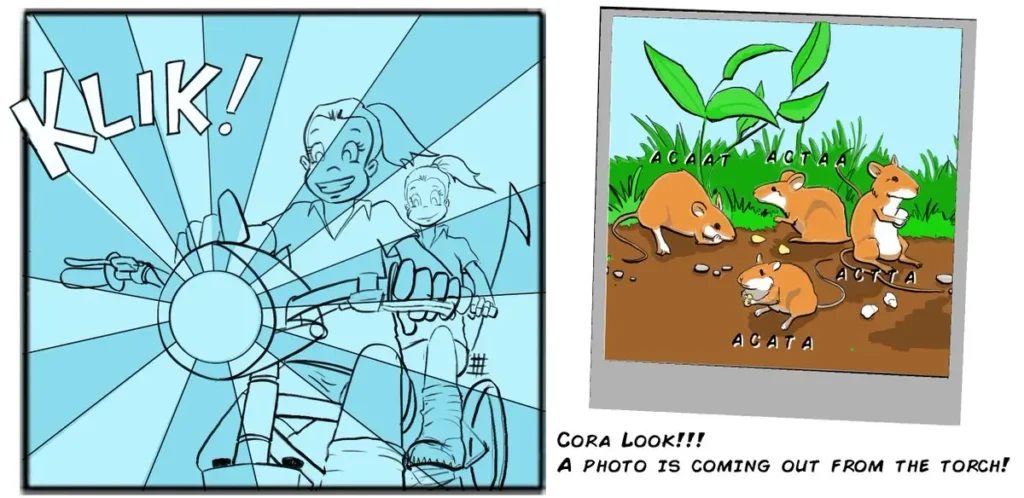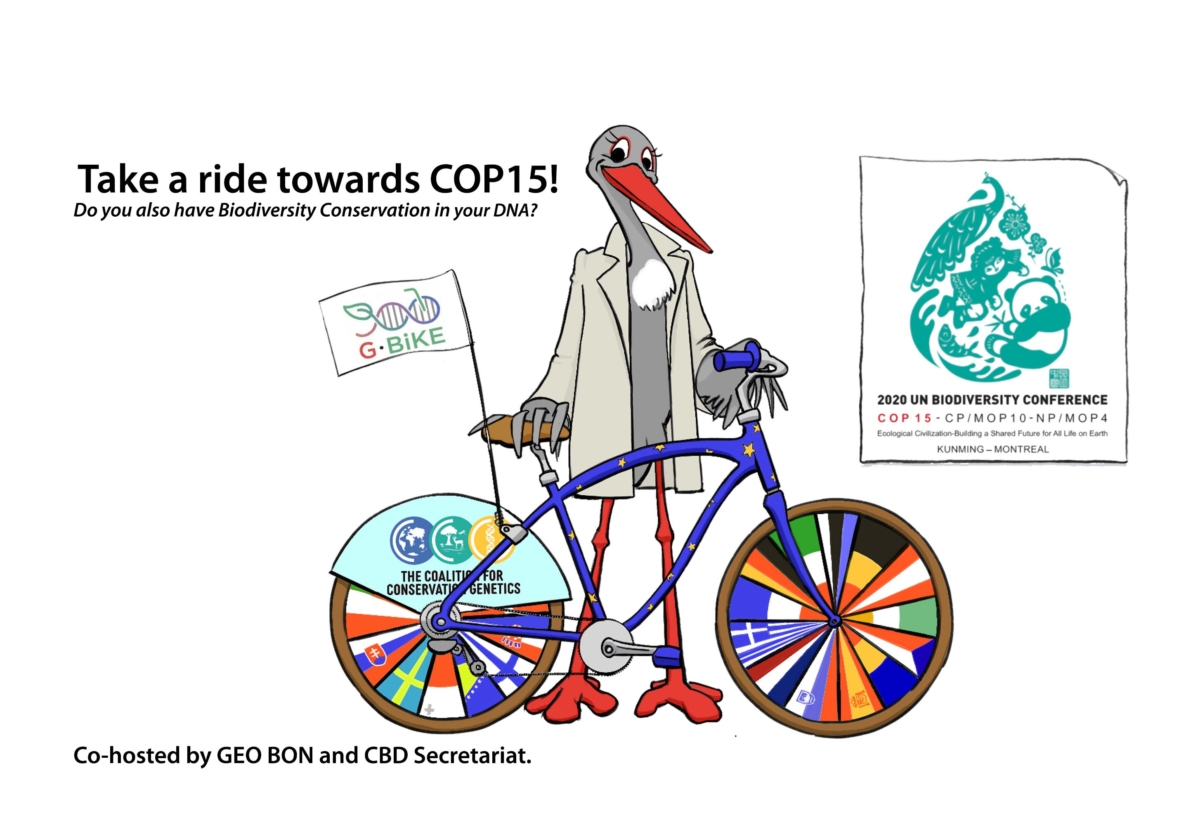Take a ride towards COP15 with G-BiKE
Blogs are written by COST Actions

G-BiKE is an interdisciplinary network of researchers and practitioners from Europe and beyond, with more than 120 participants from 42 countries currently involved. G-BiKE aims to ensure the framework for assessing, monitoring, and managing genetic diversity to maintain resilience and related adaptive potential of wild and captive populations.
The main aim of the Action is to help establish genomic data usage as a standard tool for monitoring and managing wild and ex-situ plant and animal populations. We recognized that raising awareness among all stakeholders, particularly the general public, about preserving the genetic side of biodiversity is crucial. Though genetic diversity is the foundation of any possibility to cope with global change, some of its aspects are invisible to the naked eye (such as the diversity between individuals of the same species), making it somewhat challenging to explain to a general audience.
To reach this target group, we originally planned to organize specific events that were then curtailed by the pandemic. Adapting to new conditions, we thought that animated videos and comics could bridge the social-distance gap and help us convey our message, thus staying on track with Action’s tasks and goals.
Using comics for science communication
Therefore, we first created two animated videos introducing the main characters, a stork and a tree, representing two elements of G-BiKE: researchers, and practitioners. But making animated videos is no easy task, and we realized that comics allow us to expand the G-BiKE characters’ community, including representatives of different stakeholders, and put them into different and relatable situations.
Modern society increasingly takes-up information in visual formats with as little text as possible. Comics tick those boxes, and people also associate them with fun. They also provide an opportunity to illustrate difficult topics and distill them into their very concepts. We were fortunate to have people with the needed skill set in our Action. And very important: COST virtual mobility grants and virtual networking support were excellent tools to bring them together for this task.

The challenges of communicating about genetics
Communicating about genetic aspects is perceived as a difficult thing to do, given its complexity. As in other fields, it is probably a good idea to break the issue up in steps and relate them to the daily aspects in our lives (babies, animals, plants, bikes, …). So, before tackling the molecular aspects, the audience should be pointed to the morphological differences between individuals within species. Shapes and colors can aid in doing so. Colors can also be very useful in the next step, in order to visualize molecular DNA structures (e.g., with colored Lego blocks) or allelic diversity (e.g., with colored M&Ms), as many geneticists do. Genes and genomes are often also referred to as words and books. In our ‘Genes on Wheels‘ comics, we use an intermediate step with sequences showing up as “codes” on “magic” polaroid pictures, postponing the explanations of genes, alleles, and molecular/laboratory techniques. Using the bike symbolism, we can visualize the whole range of biodiversity levels, from genes to ecosystems.
Dr Ciconia Nigra, Mr Fagus, Cora and Arlet

In our ‘Genes on Wheels‘ comics Dr. Nigra (the stork) and Mr. Fagus (the tree) were chosen to represent scientists and practitioners, the building elements of the G-BiKE network. By using an animal and a plant, we accomplished a balanced representation of scientists and practitioners working with both kingdoms, but also from a diversity of countries since stork and beech are common species throughout Europe.
In some of our comics (e.g., the bike race which will be published very soon), their morphological aspects are used to tell a story (e.g., to get across some barriers by flapping wings). However, it is actually the bikes that allow us to tell the full story of biodiversity (including genetic biodiversity). The bikes are symbolic for the (otherwise invisible) genetic characteristics (in addition to their morphological characteristics) and allow to compare the various species in terms of genetic diversity because the bikes have common and quantifiable aspects (spokes, wheels). Furthermore, these bike aspects can be improved (e.g., repairing spokes) just as genetic diversity of populations can be improved.

Cora and Arlet are invented to help G-BiKE relate better to a younger audience. Being twins might open some possibilities to explain more complex genetics in future editions of ‘Genes on Wheels’. The bikes also allow the characters to be dynamic and have some (outdoor) adventures.
Our objectives
We want to showcase that the biodiversity conservation of both wild and domesticated species has to include the maintenance and monitoring of genetic diversity. Only genetically diverse populations can be resilient to the changing environmental conditions, hence safeguarding the ecosystem services. However, as genetic diversity is not always readily visible (hidden genetic differences, within species), our underlying message is “what you see is not (always) what you get”. Therefore, we used familiar situations and characters in our comics to explain concept and different aspects of the genetic diversity. We showed how genetic tools can be used for conservation management. In the upcoming comics, we want to take the story to genomic level and explain how to obtain the genetic codes through sample analysis, allowing us to talk about genetic adaptations.
The main target audience are 12 to 18 year-olds. They are attracted by visual art such as comics. However, comics are also appreciated by a larger public. They lower the step to read something. The additional advantage is that they can be relatively easily translated. We tried to alternate more formal comics (e.g., the first one on G-BiKE and its goals) with cartoons/stories from everyday life (biking, school activities, friends, family, etc.). The first ones are more informative cartoons for older ages, whereas the others are more interactive/engaging for younger ages. In the future we might change the ages of the characters, according to the target age of the audience we want to reach.
G-BiKE at COP15 in Montreal and next steps
The UN’s Convention on Biological Diversity COP15 meeting in Montreal, December 7-19 2022, is one of this decade’s most important events for biodiversity conservation.

As part of the Coalition for Conservation Genetics, G-BiKE has been approved by the CBD Secretariat to send a delegation, set up a booth (area A0, no. 409), and organize a side event (ID 4512) at COP15. All our efforts were put towards COP15, and we put together an essential info pack for the CBD COP-15 participants to support them in preparation for Target 4, Goal A, and monitoring indicators discussion. Part of it was the Genes on Wheels comic series.
And since people reacted very positively to the series, we plan to take our characters further into the world of genetic diversity and its safeguarding. We also plan to translate the comics into different languages to enhance the outreach to different stakeholders at the national level.
Further information
Discover the G-BiKE website: https://www.g-bikegenetics.eu/en
Follow us on Youtube @g-bikecostaction6392 and Twitter @gbike_cost
About the authors
Belma Kalamujić Stroil
G-BiKE Grant Holder Manager & Leader of Working Group 5
University of Sarajevo-Institute for Genetic Engineering and Biotechnology, Sarajevo, Bosnia and Herzegovina
Peter Galbusera
G-BiKE Science Communication Coordinator & Co-leader of Working Group 5
Antwerp Zoo Society, Centre for Research and Conservation (CRC), Antwerp, Belgium
Cristiano Vernesi
G-BiKE Action Chair
Forest Ecology Unit, Research and Innovation Centre – Fondazione Edmund Mach, San Michele all’Adige, Italy
Adi Habul
Member of Working Group 5 & comic illustrator
Environmental Fund of the Federation of Bosnia and Herzegovina
